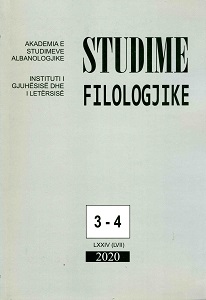Vlera aspektore e të kryerës së gjuhës shqipe
The aspect values of the perfect tense in the Albanian language
Author(s): Leonard DautiSubject(s): Language studies, Theoretical Linguistics, Syntax, Lexis, Semantics, Philology
Published by: Qendra e Studimeve Albanologjike
Keywords: Albanian language; perfect tense;
Summary/Abstract: The object of the present paper is the aspect of the perfect tense (kam shkruar ‘have written’) of the Albanian language, analysed as part of a triad connection, who’s other two members are the imperfect and the aorist tenses, three verbal constructs belonging to the same grammatical tense: the past. The analysis applied in this paper to determine the aspect value of the perfect tense of the Albanian language is based on the contemporary theoretical achievements about aspectuality, regarding the aspect as one of its constituent components. All three of these verbal constructs oppose each other in both temporal and aspectual terms. The temporal meaning of the imperfect is related to a temporal moment of the past and detached from the speech act moment. The aorist has an unlimited time span in the past. The perfect has a time span from a point of the past to the speech act point. But the essential difference between these three tense constructs is based on the different aspect that characterizes them. It has been paid attention to the theoretical distinction between aspect, aspectuality and aktionsart, as three categories that belong to different levels of the language: aspect belonging to the grammar; aspectuality as semantic and cognitive category belonging to the discourse; aktionsart belonging to the lexical semantic of the verb. This distinction is reflected in the respective terminology used here: the terms ‘perfect’, ‘imperfect’ and ‘fulfilled’ are used to define the aspect of the verbal forms; those ‘event’, ‘state’ and ‘process’ are used for the aspectual values of the sentence. In today’s Albanian language, the aspect does not enjoy the status of a systematic morphological category, as the presumed classical morphologically marked opposition: the perfect aspect - the imperfect aspect, has disappeared. In the present Albanian language cannot be identified a certain morphological morpheme as a marker o fthe perfect or the imperfect aspect. But, nevertheless, paradigmatic oppositions, which are mainly based on the aspect feature, are testified, such as that between the imperfect and the aorist, or between the synthetic present and the analytical constructions of the type po shkoj T am going’ and jam duke shkuar T am going’. An opposition which is encountered symmetrically even in the imperfect. It can be argued that the oppositions that have reorganized the forms of the verbal system are based on the grammatical category of tense, while the aspect emerges as a secondary factor participating in this organization. On the other hand, each tense construct is characterized by a special aspect, which together with the Aktionsart participates in the aspectuality of the sentence. Having as the main purpose of this paper the definition of the aspect of the perfect of the Albanian language, we have judged as the most appropriate way to take into account the threefold opposition of the past tenses: imperfect - aorist - perfect, which has dictated to first determine the aspect value of the imperfect and the aorist. The characterization of the aspect of each construct is presented through the respective frame created according to the participating components: tense axis; state of affair (antecedent and subsequent state of affair), the initial and final boundary of the state of affair; the time referents: the speech act point (to), the moment of the past point (t«i); the viewing point V. Taking into account all the temporal and aspect referential points has allowed me to determine the exact aspect differences between the three constructs in review. Considering the aspect as the narrator’s special point of view of the development of a state of affairs in time, in defining the frame of each tense construct has been evaluated the necessity of defining the viewing point, as a different instance from that of the speech act point. The temporal structure of the state of affair is conceived consisting of three elements: the initial boundary, the internal temporal development and the final boundary. The positioning of the temporal and aspectual points in relation to the state of affair, respectively with the initial boundary, the internal temporal evolution and its final boundary, enables the presentation of the respective frame that correspond to the aspect of each verbal tense construct. Whereas in the case of the imperfect and of the aorist the narrator views the state of affair from an external observation point, placed in the past, in the case of the perfect the observation point coincides with the moment of speech act; the narrator observes a certain state of affairs from a present moment of discourse. This means that the focus does not include the initial boundary and the temporal development of the state of affairs, but only its final boundary. This boundary also marks the transition to a new state of affairs. So, we have the transition from a process to a new predicative state. Precisely, on the basis of such an analysis we have defined the aspect of the perfect tense as a completed aspect. The perfect tense gives the end of a state of affairs and the transition to a new state, which is its result or consequence. This aspect value of the perfect tense is its invariant.
Journal: Studime Filologjike
- Issue Year: 2020
- Issue No: 03-04
- Page Range: 153-182
- Page Count: 30
- Language: Albanian

